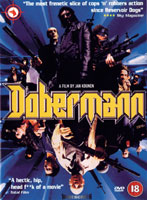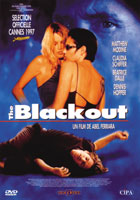DVDs
Uncut, uncensored and unreleased – by hooking up with a code-free DVD player, the cult video fanatic can enlarge his or her world of viewing pleasure 100-fold. Here Scooter McCrae tells you how to circumvent region coding and selects six great DVD imports, including films by Abel Ferrara, Luc Besson and Stanley Kubrick.
As Americans, we have certain expectations about the state of our film culture. Cinema revival houses will continue to vanish. It will be harder and harder to see both classic and cult movies projected on a screen. But technology may, as it often does, come to the rescue as the DVD craze has unleashed a seemingly limitless flow of new titles from esoteric labels as well as the major studios into video stores every week.
But what are the limits of "limitlessness"? Are what’s in our video stores the best possible video representations of our favorite films? Are films advertised as "uncut" really so? (Image’s recent release of Abel Ferrara’s Ms. 45 is one that’s not.) And what about the rest of the planet? Most video stores have a foreign film section that makes it appear as if only five films are made outside the U.S. each year.
If, adventurous viewer, questions like these keep you up at night, you’ve come to the right place. Allow me to introduce myself: I am a disgruntled American cineaste with a taste for something, well … let’s say special. I’m one of those crazy people who wants to see Eyes Wide Shut the way Stanley Kubrick intended. I want to hear what David Cronenberg has to say about his creative process while he worked on eXistenZ. And sometimes I just want to check out a title that American distributors find too bizarre, controversial or just plain uncommercial to release Stateside. There is, quite literally, a world of choice out there, and armed with a couple of basic technical facts and a curious hunger for obscure and unique cinema, there is a fabulous, adventure-filled journey of discovery to be had.
Let’s start with the region code number that is printed on the back of your DVD player. For 99 percent of you, this number will be Region 1. Think of your DVD player as a lock and the DVD disc as a key. The standard U.S. DVD player will spin only Region 1 and Region 0 (i.e. regionless) software. If you try, for example, playing a Region 2 DVD from Japan – even though the Japanese, like the U.S., employ the NTSC video standard –your player will either eject the disc or display an onscreen text message telling you how naughty you’re trying to be. There are, in fact, six separate regions and three different video standards, NTSC and PAL. Region 1 is the U.S. and Canada (both NTSC), Region 2 is Europe (PAL) and Japan (NTSC), Region 3 is Southeast Asia (NTSC), Region 4 is Latin America and Australia (both PAL), Region 5 is Russia, Africa and whatever else is left of Asia (all three PAL), and Region 6 is China (NTSC).
Region encoding exists only to stagger film releases into specific markets. For example, a Hollywood blockbuster might be released in Europe six months after it has finished its run here in the States; potential box office revenue is considered at stake if overseas viewers obtain the U.S. DVD before their local theatrical release. Hence, region codes protect cinema capitalism throughout the world!
Realizing that there was a whole world of DVD releases unplayable on my Region 1 player, I began researching code-free DVD players that were also multi-system (i.e. PAL and NTSC) on numerous U.K. websites. I finally decided on a well-reviewed and relatively inexpensive (around $400) Pioneer DV-525 unit. Trundling off to compare prices and availability at various "overseas-video" product stores in New York’s midtown area, I eventually stumbled into a spartan, wood-paneled pit called U.S.A. Electronics (125 West 45th Street) with a very accomodating staff. Within 24 hours I had the deck and a good but relatively inexpensive (around $600) Hitachi CF-2980FS multi-system television – the only way to truly reap the full benefits of world video. That’s because while having a code-free player may make all discs playable in terms of region coding, you will still be at the mercy of NTSC and PAL standard differences if you don’t have a player and television that automatically adjust themselves.The infamous Apex DVD player sold by Circuit City (before it was pulled from the market and adjusted) actually transcoded the PAL signal into an NTSC signal so you could watch any DVD on a regular NTSC television. The truth is, though, that it did a pretty crappy job of transcoding, thus destroying all the visual benefits of the PAL signal. Maybe it was some kind of conspiracy to make people think that NTSC could look better than PAL.
 |  |  |
 |  |  |
Why go to all this trouble to go "international" with your DVD system? Here are six good reasons:
Blackout(1997) – How is it, you might wonder, that native New Yorker Abel Ferrara can make a film that gets released on French DVD but doesn’t even get a token VHS video release here in the U.S.? Well, you’ve got me. Blackout stars Matthew Modine as an unrepentant substance abuser meandering his way through a typically seedy series of surreal goings-on until, well, something pretty damn eventful maybe happens. Powerful supporting performances from Dennis Hopper, Beatrice Dalle and Claudia Schiffer help ground the film’s woozy incidents. The PAL Region 2 release is a crisp, solidly colorful transfer with a little bit more artifacting than it should have. It includes a trailer and 15 minutes of behind-the-scenes material depicting Abel chugging a bottle of Red Stripe beer while directing, yelling arcane orders to oblivious crew people, etc. Unfortunately, you can’t deactivate the French subtitles while listening to the English-language track. But if you’re trying to learn conversational gutter-French, this could be the Rosetta Stone-bonus feature that will make you have to buy it.
Eyes Wide Shut (1999) – Stanley Kubrick’s final litmus test deserved a whole lot better than being compared (unfavorably, no less!) to some kind of late-night Cinemax Zalman King fodder – and this from the supposedly professional "critics"! The MPAA vegetables didn’t do much to help matters, and Warner Bros. caved like a house of cards to the Board’s puritanical wishes, imposing digital shadow-puppets over the film’s naughty bits. But with a couple of viva la revolucion mouse clicks, one can obtain an uncut, uncensored and digitally unmasked DVD of Kubrick’s last masterpiece. And while Warner Bros. gave us a fine NTSC transfer, the 100 extra lines of the PAL Region 2 version allow much sharper and richer colors to push their way out through the cathode tube.
eXistenZ (1998) – Ahh, Miramax. The Region 1 Canadian import DVD of David Cronenberg’s virtual-reality mind fuck offers not just a beautiful 16x9 enhanced transfer of the film but also generously includes three audio commentary tracks (by director David Cronenberg, director of photography Peter Suschitzky and special effects supervisor Jim Isaac) and a wonderful one-hour documentary about Cronenberg’s longtime production designer Carol Spier. By contrast, the American edition includes . . . well, actually, it includes absolutely nothing and will probably cost you more than the easily obtained Canadian version! Similar Miramax penny-pinching can be found on the American Pulp Fiction, Trainspotting and Holy Smoke discs, all of which lack the extra features and audio commentaries found on the non-American versions.
Dobermann (1997) – Based on Joël Houssin’s series of cult French pulp novels, this sick little puppy delivers the action-adventure goods and then some. Vincent Cassel stars as firepower-crazy super-thief Dobermann, and Tchéky Karyo is the ruthlessly immoral cop who will stop at nothing to bring him down hard. The first 10 minutes contain some of the most nitrously overcharged cinematic storytelling to burn across the screen in a long time; a huge gun accidentally tossed into the lap of baby doberman becomes part of an across-the-screen transitional wipe that morphs the child and adult gun-toting doberman over a 25-year span!
For the past three years Dobermann has been collecting dust in the vast acquisition vaults of the fine folks at Miramax, waiting to be dubbed into English or re-made with Americans or softened into pap. Whatever. The U.K. Region 2 release is a good-looking DVD, but, unfortunately not a great-looking one, transferred from a dark and contrasty print. The French-only soundtrack is a powerful Dolby Pro-Logic Surround monster with booming gunplay and pulsating, full-bodied music to burst your speakers. The film is soon to be released in France (sans subtitles, sadly) as a two-DVD special edition with audio commentary, 12 deleted scenes, and making-of segments.
Muertos de Risa (1999) – The title translates as "Dying of Laughter," and this very dark comedy (PAL, Region 2) documents the meteoric rise and catastrophic fall of Nino and Bruno, a comedy team whose one unique talent consists of Nino taking slaps across the face from Bruno. Director Álex de la Iglesia (The Day of the Beast and Perdita Durango) plants the film firmly in the 1970s, allowing him to take full advantage of the grotesque fashion lunacy and garish color designs of that era. Furthermore, he weaves his imaginary duo into some of the key South American political events of the day, sometimes via computer manipulation of historic images. Round it all off with a cameo appearance by Uri Geller, and you’ve got a comedic tale of life-destroying paranoia that covers all the bases of retro-references. The 1.85 (non-enhanced) widescreen transfer is sharp and colorful, and though it doesn’t bill itself as a special-edition disc, it’s got enough supplementary material to make the claim. Only one complaint: an absolutely terrible layer change in the middle of a quick panning shot. What were they thinking?
Le Dernier Combat (1983) – Luc Besson’s first feature, The Final Combat is a science fiction adventure that posits a future France reduced to an ash-covered wasteland in which everyone has lost the power of speech. Explanation? None. Highlights include the dark comic hijinks of a young Jean Reno and the barren skies suddenly opening into a rainstorm of dead fish. This French DVD is a beautiful 2.35 widescreen enhanced transfer that captures every dull shade of gray between the harsh blacks and whites of the stark cinematography. The only U.S. video release of this film was back in the mid 1980s, a long out-of-print Key Video presentation that hacked the sides off the vast Cinemascope frame and imprisoned it within TV’s square box. An even rarer Japanese widescreen laserdisc appeared and just as quickly vanished in the early 1990s, but this recent transfer from France is obviously the most luminous and detailed of the bunch.
Bummed that you bought your DVD player before reading this article? Try visiting Code-Free DVD players (codefreedvd.com), a company that manufactures and installs custom chips that make your already purchased DVD player amenable to all six region codes from around the world.
VOD CALENDAR


 See the VOD Calendar →
See the VOD Calendar →


